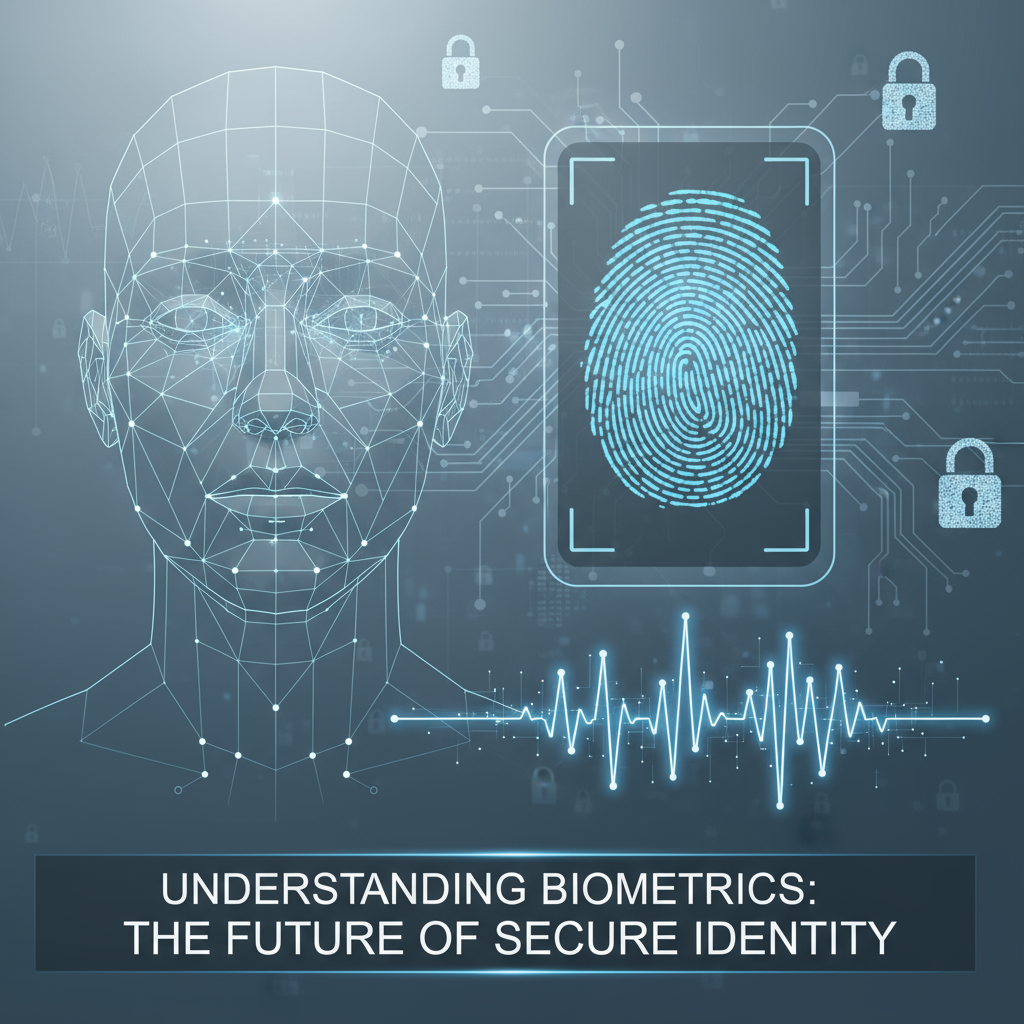Biometrics is no longer futuristic—it’s part of our everyday lives. From unlocking smartphones with your fingerprint to scanning your face at an airport kiosk, biometric sensors are reshaping the way we identify ourselves and access services. But what exactly are biometrics, and how do the devices and sensors behind them work?
In this blog, we’ll explore what is biometric sensor, the different types of biometric devices, how they work, where they are used, and the challenges that come with them.
What is Biometrics
Biometrics refers to technologies that use unique human characteristics—like fingerprints, faces, voices, or irises—for recognition and authentication. Unlike passwords or ID cards, biometric traits are nearly impossible to duplicate.
At the heart of this technology lies the biometric sensor input device—the hardware that captures biological data, converts it into a digital format, and matches it with stored templates.
This is why biometrics is considered more secure, convenient, and user-friendly compared to traditional identification methods.
What Are Biometrics? Devices and Sensors
Before diving deeper, let’s answer the key question: What is a biometric sensor?
A biometric sensor is a device that detects and measures physical or behavioral traits such as fingerprints, facial features, voice patterns, or heartbeat rhythms. It converts this data into a digital signal and compares it with pre-stored information to either verify or identify a person.
In simple words: Biometric sensors are input devices that capture unique biological data.
What Is a Biometric Device?
A biometric device is the complete system that uses these sensors to perform authentication. While the sensor captures raw data (like a fingerprint image), the device also includes processing software, storage, and communication systems to deliver results.
Examples of biometric devices:
- Fingerprint scanners in mobile phones.
- Facial recognition cameras at airports.
- Iris scanners in government ID programs.
- Voice recognition systems in banking.
Together, biometric sensors and devices form the backbone of secure authentication systems across industries.
Types of Biometric Sensors
Biometrics is a wide field, and there are several types of biometric sensors based on the characteristic they measure. Let’s explore the most important ones.
1. Fingerprint Sensors
![]()
Perhaps the most common type of biometric sensor input device is the fingerprint sensor. These sensors scan the unique ridges and patterns of a person’s fingertip.
- How it works: Light, capacitive, or ultrasonic technology captures the fingerprint.
- Where it’s used: Smartphones, office attendance systems, ATMs, and border security.
- Advantages: High accuracy, cost-effective, fast recognition.
- Challenges: Fingerprints can be affected by cuts, dirt, or worn ridges.
2. Facial Recognition Sensors

Facial recognition sensors analyze facial features such as the distance between the eyes, nose shape, and jawline. Modern versions even use 3D mapping and infrared sensors for accuracy.
- How it works: Camera captures an image → software converts it to a facial template → compared with stored templates.
- Where it’s used: Airports, surveillance systems, smartphones, and smart homes.
- Advantages: Quick, contactless, user-friendly.
- Challenges: Lighting conditions and privacy concerns.
3. Iris and Retina Scanners

Iris scanners capture the colored ring of the eye, while retina scanners focus on unique blood vessel patterns inside the eye. Both are highly secure forms of biometric authentication.
- How it works: Infrared light highlights eye patterns → captured and digitized by a sensor.
- Where it’s used: High-security areas like defense, government, and healthcare.
- Advantages: Extremely accurate, nearly impossible to replicate.
- Challenges: Expensive, requires user cooperation.
4. Voice Recognition Sensors
Voice recognition is based on the unique sound waves created by vocal cords, tone, and speaking style.
- How it works: Microphones (acting as biometric sensors) capture voice input, which is analyzed for pitch, cadence, and frequency.
- Where it’s used: Call centers, mobile banking, smart assistants (like Alexa, Siri).
- Advantages: Non-intrusive, convenient.
- Challenges: Background noise or illness can alter voice.
5. Heartbeat and Vein Pattern Sensors
These are emerging technologies in the field of biometric sensors. They measure internal characteristics like heartbeat rhythm or the unique pattern of veins in your palm or hand.
- How it works: Infrared light maps vein structures; sensors pick up heartbeat signatures.
- Where it’s used: Wearables, fitness trackers, and healthcare.
- Advantages: Harder to fake, continuous monitoring possible.
- Challenges: Still developing, costly.
How Biometric Sensors Work
To understand biometrics better, let’s break down the working of a biometric sensor:
- Data Capture – The biometric sensor input device records raw data (fingerprint, face, voice, etc.).
- Conversion to Digital Template – Data is converted into numerical values (digital templates).
- Storage – Templates are stored securely in a database or device memory.
- Matching – When a user attempts authentication, the new scan is compared with the stored template.
- Decision – System either verifies (one-to-one match) or identifies (one-to-many match) the person.
Also Read: What is Iris Recognition Software?
This process happens in milliseconds on modern biometric devices.
Applications of Biometrics and Sensors
Biometrics is everywhere—from consumer electronics to national security. Here’s how biometric sensors are applied:
- Security and authentication: Unlocking phones, accessing corporate networks, controlling entry to restricted buildings.
- Healthcare: Patient identification, remote monitoring, wearable devices that track vital signs.
- Banking and finance: Fingerprint ATMs, voice authentication for transactions, fraud prevention.
- Government and law enforcement: Border control, e-passports, Aadhaar in India, criminal investigations.
- Consumer technology: Smart homes, IoT devices, e-learning platforms.
Benefits of Biometric Sensors
Accuracy and Reliability
One of the biggest advantages of using a biometric sensor input device is its high level of accuracy. Biometric traits such as fingerprints, iris patterns, or facial structures are unique to each individual.
Unlike traditional methods like passwords or ID cards—which can be forgotten, lost, or stolen—biometrics provide consistent and reliable identification.
This uniqueness drastically reduces the chance of fraud or impersonation, making biometric devices trustworthy for critical applications such as banking, border control, and healthcare.
Convenience
Biometric sensors eliminate the need to remember multiple passwords or carry access cards. All you need is your fingerprint, face, or voice.
For example, unlocking a smartphone with a fingerprint sensor is much faster and easier than typing a PIN. This convenience extends to businesses as well—employees can simply scan their fingerprints or faces to mark attendance or access restricted areas, saving time and reducing administrative overhead.
Speed
Modern biometric devices are designed to process data within seconds. Once a biometric sensor captures data, the system matches it against stored templates almost instantly.
This speed improves user experience, especially in high-traffic environments such as airports, where thousands of travelers can be verified quickly. The rapid verification also reduces queues and improves overall efficiency in workplaces, retail outlets, and financial institutions.
Scalability
Biometric technology is not limited to individuals—it can be scaled to serve small businesses, multinational corporations, or even entire nations.
For example, India’s Aadhaar program uses biometric sensors to manage the identities of over a billion citizens. Small companies can use fingerprint scanners for attendance tracking, while governments can employ iris or facial recognition systems for large-scale identity verification. The flexibility and scalability of biometric devices make them suitable for organizations of all sizes.
Security
Traditional identification methods such as passwords or access cards can be easily shared, duplicated, or stolen. Biometric data, on the other hand, is far more secure because it is tied directly to an individual’s physical or behavioral traits.
For instance, fingerprints or iris patterns cannot be casually replicated. Advanced biometric sensors also use encryption to store data securely, reducing the risk of cyberattacks or identity theft. This makes biometrics one of the strongest security layers available for both personal and enterprise use.
Challenges and Future Directions
Despite advantages, biometric sensors face challenges:
- Privacy concerns – Storing biometric data raises fears of misuse.
- Data security – Databases must be encrypted to avoid breaches.
- Bias and errors – Some systems perform differently across demographics.
- High costs – Advanced biometric devices like iris scanners can be expensive.
Future of Biometric Sensors
- Integration with AI and analytics for higher accuracy.
- Growth of multimodal biometrics (combining fingerprint + face + voice).
- Use in wearables for continuous authentication.
- Wider adoption in e-governance, banking, and smart cities.
Conclusion
Biometrics has moved from science fiction into everyday reality. At its core, it depends on the biometric sensor input device, which captures unique traits like fingerprints, faces, or voices and turns them into secure digital identifiers.
So, when we ask, “What is biometric sensor?”—the answer is simple: it’s the technology that allows us to use our very identity as the key to security.
Whether in smartphones, airports, banks, or government IDs, biometric sensors and devices are redefining how we live, work, and interact with technology. Their future lies in more advanced, ethical, and inclusive applications.
FAQ
What is biometric sensor?
A biometric sensor is a device that captures physical or behavioral traits like fingerprints, face, or voice and converts them into digital data for authentication.
What is a biometric device?
A biometric device is the complete system that uses sensors and software to capture, store, and match biometric data for verification.
Where are biometric sensors used?
They are used in smartphones, ATMs, airports, healthcare systems, and government ID programs.
Are biometric sensors safe?
Yes, but they must be combined with secure storage and encryption to protect against misuse.
What is the future of biometric technology?
The future includes AI-powered recognition, multimodal systems, wearable authentication, and integration into smart cities.




